Vol 4 No. 12 TROPIC LIGHTNING NEWS March 24, 1969
Index
NVA Find Deuces Wild, Lose 28 Near Dau Tieng
By SP4 D.J. Caldwell
DAU TIENG - An enemy force paid dearly for an attempt to overrun a
Triple Deuce position three miles west of Dau Tieng, as 28 North Vietnamese Army
soldiers were left behind dead on the battlefield.
Not a single casualty was sustained by Bravo Company, 2d Battalion
(Mech) 22d Infantry during the four-hour fight in which they raked the enemy
with machinegun fire, small arms, and a devastating barrage of mortars and
artillery.
A warning of the attack had come two days earlier when the company
killed three members of a five-man enemy reconnaissance patrol which was
camouflaged with charcoal. After the mechanized infantrymen fired at the
NVA patrol, they discovered three bodies outside the perimeter.
When the much larger attack came shortly before midnight two days
later, the company, commanded by Captain John Johnson of Missoula, Mont., was
ready.
From a vantage point atop a high bunker, members of the 3d Brigade
company spotted enemy soldiers coming toward their perimeter. At the same
time, members of a command observation post several hundred meters outside the
wire spotted heavy movement and were told to pull back.
"We came to within 100 yards of the perimeter but could still see
groups of five to 15 enemy advancing toward the company," said Sergeant Aubry
L. Crumb of New Orleans."
Crumb's patrol came back within the perimeter to engage the enemy
as the Triple Deuce company opened up with its heavy organic weapons.
Artillery support from Charlie Battery, 2d Battalion, 77th
Artillery in Fire Support Base Wood and Alpha Battery, 1st Battalion, 27th
Artillery in Dau Tieng began pouring deadly fire on the attackers.
While enemy mortars, RPG's and heavy small arms fire hit around
the company's armored personnel carriers, Johnson got on top of the
position's highest bunker and observed enemy movement through a starlight
scope. He directed the company's fire so effectively that no enemy
approached any closer than 50 meters from the Perimeter.
During the height of the battle an 81mm counter-mortar round fired
by Triple Deuce mortarmen apparently struck in the midst of an enemy mortar
crew, sending up a secondary explosion and silencing the NVA tube.
A sweep of the battle area the following morning turned up the
bodies plus four enemy RPG launchers and 25 rounds, three AK-47 assault rifles
and several hundred rounds, six bangalore torpedoes, two anti-tank mines and 151
Chicom hand grenades.
|
MAJOR GENERAL Ellis W. Williamson (second from left), 25th Division commanding general, stands on battleground where 28 enemy died in an attempt to overrun a night position of Bravo Company, 2d Battalion (Mechanized), 22d Infantry. Directly to the right of Williamson is Lieutenant Colonel Ralph A Cline of Rockford, Md, commander of the Triple Deuce battalion. The attack on Bravo Company turned out to be the first in a series of large-scale attacks against 3d Brigade installations. |
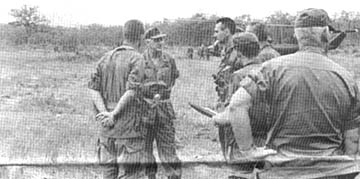 |
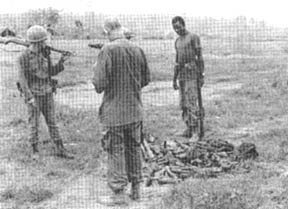 |
EVALUATING THEIR VICTORY, members of Bravo Company tally the weapons left behind by the NVA after the all-night battle three miles west of Dau Tieng. (PHOTOS BY SP4 D.J. CALDWELL) |
| It is our individual responsibility to be absolutely certain that the safety concept enters into everything we do here in the war zone. We cannot assume that accidents always happen to the "other guy." Accidents can happen to anyone. Don't be foolish. Think safety! |
'Rubber' Commo Holed In Bunkers
Story And Photo
By CPT R. A. Steinhausen Jr.
DAU TIENG - Through long rows of rubber trees, an infantryman could
see a bunker complex interspersed with fences, antennas and communications wire.
"It looks spooky to me," he thought.
But the scene was not a combat operation or reconnaissance in force
mission. In fact, the G.I. was coming out of the Dau Tieng post exchange.
The bunker complex is not an enemy position, but the home of
communications in Dau Tieng base camp, 45 miles northwest of Saigon. It is
in underground bunkers for security reasons.
Inside the bunkers, which belong to the White Platoon,
587th Signal Company, more than sixty signalmen work shifts day and night to
keep the lines of communication open between Dau Tieng and outlying points.
The communications network is operated for the 3d Brigade by the
platoon, which is part of the 86th Signal Battalion 'Varsity'.
"The men like to work in bunkers," said First Lieutenant Robert
J. Kwiatkowski of Central Valley, N.Y. "They can do their jobs
undistracted by the possibility of enemy rockets and mortars."
The concept is so successful, in fact, that the White Platoon is
undertaking construction of a 'super bunker' which will enable them to
consolidate all of their switchboards, radios and wire hookups. The giant
bunker was a brain-child of First Lieutenant Gerald Clark of Manhasset, N.Y., an
architect before entering the Army. By putting everything in one spot, it
is expected to save work.
The project to build the super bunker is being carried out under
the supervision of Platoon Sergeant Harry L. Anderson of Auburn, Wash.
"They're not exactly engineers, but my men are learning
fast," he said.
While working on the new center, the signalmen continue to man
their radios and switchboards, which include radio hookups to other base camps,
teletypes, and a MARS (Military Affiliate Radio System) Station, which enables
men to call home. Specialist 4 Eddie Lomas of Gonzales, La., chief
operator on the central switchboard, noted that during a typical day each of the
operators averages twice as many calls as a long distance operator in the
states.
After a long shift, the friendly voice which answers "Dau Tieng,
sir," each time the phone is picked up may almost be reduced to a hoarse
croak.
In another bunker, the Wire Head section brings together the
hundreds of miles of wire which connect communications between infantry,
artillery and support units in Dau Tieng.
The job of tracing out possible bad circuits is never-ending, as
Vietnam's heat and dust contribute to the quick demise of splices.
Perhaps the MARS Station is the part of the platoon's service
most appreciated by Tropic Lightning soldiers. On a typical night some 25
infantrymen - sometimes twice that number - are connected halfway across the
world to loved ones at home.
The MARS Station not only serves men in the base camp, but, thanks
to a seven-radio hookup, is now able to connect men atop 3,400 foot Nui Ba Den
to the folks at home on a weekly basis.
| MICROWAVE TOWER - Sticking out above the Michelin Rubber Plantation, the White Platoon's microwave relay tower beams signals in several directions to other base camps and to Nui Ba Den. | 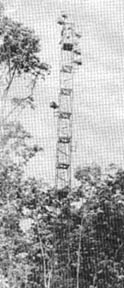 |
DIVARTY Gets New Leader
CU CHI - Colonel John S. Wieringa assumed command of Division
Artillery in ceremonies held at Cu Chi base camp.
The new commander received the DIVARTY colors from Colonel Lucius
G. Hill, Jr., who moves to the Military Assistance Command Vietnam (MACV), for
duties as Public Information Officer.
In remarks at the change of command ceremony, assistant Division
Commander Brigadier General Edwin F. Black lauded the cannoneers of DIVARTY
units specifically praising their mobility and quick reaction in providing fire
support for the Tropic Lightning Division.
Colonel Hill also had words of praise for the men of DIVARTY.
Represented were cannoneers of 105mm units within DIVARTY - 2d Battalion, 77th
Artillery led by Lieutenant Colonel Vernon Lewis; the "Professionals" of the
1st Battalion, 8th Artillery with Lieutenant Colonel John Cooper in charge the
7th Battalion, 11th Artillery commanded by Lieutenant Colonel Walter L. Wood
III; and the 3d Battalion, 13th Artillery, the composite battalion of 155mm and
eight inch self-propelled howitzers, led by Lieutenant Colonel Paul Donavan.
Lightning CG Earns DFC
CU CHI - Major General Ellis W. Williamson received the
Distinguished Flying Cross on March 9 for heroic actions while flying in a
Command and Control helicopter during the recent surge of Communist activity.
On February 23,1969, two rifle companies from the 2d Battalion,
27th Infantry, came under massive Communist fire followed by human-wave
assaults.
In the midst of treacherous enemy fire, the Tropic Lightning
Commanding General ordered his aircraft commander to make low-level passes over
the embattled area, during which General Williamson pinpointed enemy troop and
weapons locations. As a result of his courageous action and incisive
calculations, maximum firepower was directed against the enemy, and the
integrity of the patrol base was preserved.
Page 2 TROPIC LIGHTNING NEWS March 24, 1969
Decorated
| Bronze Star
Medal For Heroism |
|
| LTC William J. Cummings
HHC, 2d Bn, 14th Inf MAJ George B. Sweet, 25th MI Det CPT James F. Harvey, C Btry, 7th Bn, 11th Arty 1LT Lauren E. Johnson, 2d Bde Mobile Training Team 1LT Gary G. Martin, HHC, 1st Bn, 5th Inf 1LT James W. Conway, A Btry, 7th Bn, 11th Arty 1LT Gary W. Carlson, B Trp, 3d Sqdn, 4th Cav 1LT Michael D. Jackson, C Trp, 3d Sqdn, 4th Cav 1LT Demus Gnas, Co D, 2d Bn, 12th Inf 1LT Andrew D. Malloy, Co B, 1st Bn, 5th Inf 1LT Jerry D. Pruitt, HHC, 2d Bn, 12th Inf 1LT John W. Slawson, Co C, 2d Bn, 27th Inf 1LT Andrew C. Allred, Co A, 1st Bn, 5th Inf 1LT Eddie G. Riggsby, Co A, 2d Bn, 14th Inf 1LT Michael D. May, Co D, 1st Bn, 27th Inf 1LT John R. Moore, A Trp, 3d Sqdn, 4th Cav 2LT Jerome P. Klar, A Trp, 3d Sqdn, 4th Cav 1SG Harvey L. Harper, Co B, 1st Bn, 5th Inf 1SG Ernest C. Randolph, Co A, 1st Bn, 27th Inf 1SG Douglas C. Raab, 25th MI Det MSG Phillip F. Dice, HHC, 1st Bn, 5th Inf PSG Robert C. Lewis, C Trp, 3d Sqdn, 4th Cav SFC Nathaniel R. Meador, Co C, 1st Bn, 27th Inf SFC Herbert D. Wright, Co C, 1st Bn, 27th Inf SP6 Tommy D. Bass, HHC, lst Bn, 27th Inf SSG David D. Buckner, HHC, 1st Bn, 27th Inf SSG Stephen B. Duerk, Co B, 1st Bn, 5th Inf SSG Emmanuel G. Montanez, A Trp, 3d Sqdn, 4th Cav SSG Tommy Brewington, A Trp, 3d Sqdn, 4th Cav SSG Levern C. Brown, A Trp, 3d Sqdn, 4th Cav SSG Jack B. Kimberlin, B Trp, 3d Sqdn, 4th Cav SSG Alejandro, Co D, 3d Bn, 22d Inf SSG William D. Shaw, Co A, 3d Bn, 22d Inf SSG Ronald D. Hughes, A Trp, 3d Sqdn, 4th Cav |
SSG Thomas E. Kelly, Co A, 2d
Bn, 12th Inf SSG Bernard R. Gdowski, Co C, 1st Bn, 5th Inf SGT Billy R. Terry, Co A, 1st Bn, 27th Inf SGT La Von Freeman, Co B, 1st Bn, 5th Inf SGT Lowell E. Leopold, Co D, 2d Bn, 12th Inf SGT Cecil G. Law, Co B, 1st Bn, 27th Inf SGT William J. Haase, Co D, 2d Bn, 12th Inf SGT Roy L. Alexander, Co A, 1st Bn, 5th Inf SGT Timothy Harris, Co A, 1st Bn, 5th Inf SGT Daniel Rothstein, Co A 2d Bn, 14th Inf SGT William A. Cargill, 25th MP Co. SGT Jerry E. O'Malley, A Trp, 3d Sqdn, 4th Cav SGT Mel T. Bernard, Co F, 50th Inf SGT Gerald J. French, B Trp, 3d Sqdn, 4th Cav SGT Terry Valore, HHC, 4th Bn, 23d Inf SGT Daniel G. Updike, Co A, 4th Bn, 23d Inf SGT Glenn D. Covert, Co A, 2d Bn, 14th Inf SGT David H. Foss, Co E, 2d Bn, 12th Inf SP5 Donald E. Deck, A. Trp, 3d Sqdn, 4th Cav SP5 Thomas E. Ruschkewitcz, C Trp, 3d Sqdn, 4th Cav SP4 Richard H. Losey, HHC, 1st Bn, 27th Inf SP4 Guy S. Lopez, HHC, 1st Bn, 27th Inf SP4 James A. Leonard, HHC, 1st Bn, 27th Inf SP4 Larry P. Templeton, Co A, 4th Bn, 9th Inf SP4 Dennis A. Gilmore, Co A, 1st Bn, 27th Inf SP4 Carlton G. Harwell, Co B, 1st Bn, 5th Inf SP4 Jerome L. Bradwell, Co B, 1st Bn, 5th Inf SP4 Kenneth J. Taylor, Co D, 2d Bn, 12th Inf SP4 William C. Stuart, Co D, 2d Bn, 12th Inf SP4 Perry A. Helms, Co B, 1st Bn, 5th Inf SP4 John F. Sherwood, Co C, 1st Bn, 27th Inf SP4 Ronald A. Williams, Co D, 2d Bn, 12th Inf SP4 Henry R. Erber, A Trp, 3d Sqdn, 4th Cav SP4 Stephen A. Vanrie, A Trp, 3d Sqdn, 4th Cav |
Be A Professional Individual
The Following is extracted from the Division Commander's Combat
Notes which reflect the goals and ideals that we in the Tropic Lightning
Division strive for in the performance of our duties:
Some while back, we accepted the slogan 'Victory is the result of
Professionalism.' We also established the fact that professionalism
begins with the individual and means that he begins by taking care of himself.
The men of this division have done well in taking care of
themselves as individuals. It is a rare exception for me to see an
individual who is not a credit to this organization.
I would now like for each of us to extend our approach to
professionalism by emphasizing individual acts with respect to the utilization
of our primary instruments of war.
As an example the rifleman should approach his rifle as an entity
to include its maintenance and utilization.
We have done considerably better in the last few months with
respect to the cleanliness of our weapons. However, we have not made
adequate improvements in the realm of precision and exactness in the use of the
weapons.
We have too many occasions where men fail to do what they know to
be right. Just recently, I observed approximately a dozen of our riflemen
attempting to knock down one enemy soldier that was within 100 yards of their
position. I finally stopped them all from shooting and turned to one
man and said to him, "Take your time, take a proper sight picture, and squeeze
the trigger." One shot did the job. Well over 200 shots had been
expended in the previous five minutes without getting the job done.
During the next few weeks, let us concentrate on the precision and
exactness on the use of our individual and crew served weapons and equipment.
Let us pay particular attention to such things as having a proper sight picture
in precise shooting, the mortar sight bubbles being exactly level, and proper
alignment on the aiming stakes.
These are just a few examples that must be accomplished at the
individual level to permit us to have precision in the use of our weapons.
USAFI And GED Tickets To Success
Individuals interested in bettering their educational level for
post-military occupations or those personnel desiring career advancement can
find a wide variety of educational assistance at the Army Education Center.
Individuals who have not completed high school can achieve a high
school equivalency certificate through the United States Armed Forces Institute
(USAFI) by taking the General Educational Development (GED) test battery.
Successful completion of the GED can lead to a high school diploma from one's
State Board of Education.
Those individuals interested in gaining up to thirty hours of
college credit can be administered the USAFI College Comprehensive Test (CCT).
Still another means of receiving credit for college level study can be obtained
by enrolling in one of many diversified college correspondence courses offered
at the Education Center.
Interested personnel assigned to the Cu Chi base camp have the
opportunity to attend regular evening classes to gain academic credit for high
school as well as college courses. These courses are the same as the
correspondence study courses but are being taught in residence by qualified
teachers.
In addition, a wide variety of language courses can be taken
through correspondence study at the Education Center, for language. The
Education Center at the Cu Chi base camp offers daily classes on Vietnamese
taught by a competent Vietnamese teacher.
The 25th Infantry Division has functional Education Centers at each
of its base camps. Check with your Education Advisor at your respective
base camp.
Cu Chi ........ phonel#5132
Tay Ninh ..... phone #460
Dau Tieng .... phone #155
Tropic Lightning Tots
The Commanding General Welcomes
The Following Tropic Lightning Tots
To The 25th Infantry Division - As
Reported By The American Red Cross.
Born To:
|
February 18 PFC and Mrs. Gary E. Pedigo, Co C, 65th Engr Bn, a son February 19 PFC and Mrs. Douglas E. Hillis, Co B, 25th S&T Bn, a daughter February 21 PFC and Mrs. Lewis A. Harris, Co D, 2d Bn, 14th Inf, a son SP5 and Mrs. Timothy Knanishu, 25th Admin Co, a son February 23 PFC and Mrs. William J. Cofflni, 25th Admin Co, a daughter PFC and Nrs. Cecil R. Hamm, Co F, 50th Inf, a son PFC and Mrs. Douglas T. Crank, Co C, 2d Bn, 12th Inf, a son February 24 SP4 and Mrs. Wayne A. Brumbaugh, Co C, 2d Bn, 27th Inf, a son February 27 1LT and Mrs. John Dennis Ewelp, Co B, 2d Bn, 14th Inf, a daughter March 1 SSG and Mrs. Roland Thibeault, 25th Admin Co, a daughter March 2 SSG and Mrs. Jerry W. Lutz, A Trp, 3/4 Cav, a son March 3 SGT and Mrs. Charles Martin, Co A, 125th Sig. Bn, a daughter March 11 SGT and Mrs. C. Greer, 725th Maint. Bn., a son |
Bond Award To Two Division Units
|
Two Tropic Lightning units have been awarded the Department of the
Army's Minuteman Award for outstanding participation in the U.S. Savings Bond
program. The DA award is given to units that have assigned strength of 100 or more personnel and 75 per cent or more of the personnel are participating in the payroll deduction (B and B-1 allotments) purchase of U.S. Savings Bonds. The two units received the award at Cu Chi from Mrs. Joy Berleman who is 'Mrs. U.S. Savings Bond of 1969'. The units are Bravo Battery, 3d Battalion, 13th Artillery with 85 per cent participation, |
|
and Company E, 2d Battalion, 27th Infantry with 79 per
cent participation, and Company E, 2d Battalion, 27th Infantry with 79
per cent participation. Mrs. Berleman was on a goodwill tour of U.S. Forces in the Far East under sponsorship of the American Express Company. She was awarded the title of Mrs. U.S. Savings Bond in August 1968 during the Mrs. America Pageant in Minneapolis, where she was Mrs. New Mexico. During the year of her title she will spend over half of her time touring the United States helping the U.S. Treasury promote the sale of Bonds. |
The TROPIC LIGHTNING NEWS is an authorized publication of the 25th Infantry Division. It is published weekly for all division units in the Republic of Vietnam by the Information Office, 25th Infantry Division, APO San Francisco 96225. Army News Features, Army Photo Features, Armed Forces Press Service and Armed Forces News Bureau material are used. Views and opinions expressed are not necessarily those of the Department of the Army. Printed in Tokyo, Japan, by Pacific Stars and Stripes.
MG Ellis W. Williamson . . . . Commanding General
MAJ John C. Fairbank . . . . . Information Officer
1LT John C. Burns . . . . . . . . Officer-in-Charge
SP4 Stephen Lochen . . . . . . Editor
SP4 Charles Withrow . . . . . . Assistant Editor
SP4 Jim Brayer . . . . . . . . . . . . Production Supervisor
Page 3 TROPIC LIGHTNING NEWS March 24, 1969
New Leg And New Spirits For Young Viet Cong Victim
CU CHI - It was a combination of surprise and pleasure for Tropic
Lightning 2d Brigade staffers when Tran Van Bao returned from Saigon's
National Rehabilitation Center able to walk on his new artificial leg.
Despite weeks of planning and careful coordination with families,
agencies and military channels the first complete success was nonetheless, a
welcome surprise.
And with that success, the project got an approving nod for more
such operations that will see dozens of handicapped Vietnamese in Hau Nghia
Province receiving new limbs.
Soon the second group of four will be taken to the Rehabilitation
Center for prosthetic consultation. The first group reported to the center
in early March.
These first eight, in addition to Tran Van Bao, come from three
districts in Hau Nghia and have disabilities including amputated arms and legs.
The importance of this project is two-fold: First, it
accomplishes a portion of the MACV mission by aiding the people of Vietnam; and
second, it demonstrates concern of the allies for individuals.
Without the cooperation of the Saigon Center, a Vietnam project of
the World Rehabilitation Fund, Inc., the project would have been difficult, if
not impossible. The Project headquarters, headed by Robert B. Wildon,
carries on in the humanitarian tradition established several years ago by
founding chairmen Bernard Baruch, Herbert Hoover, and Harry Truman.
With funds from international support groups and donations the
Saigon Center treats hundreds of patients free-of-charge each month.
While at the center, Tran Van Bao, a 12-year-old villager was given
an artificial hand and leg and three weeks of therapy and training in their use.
When the boy returned home he became a new person, a participant
instead of a spectator and a contributing member of his family.
The eight Vietnamese now going through the Center range from a
45-year-old mother who lost an arm in 1967 to another eight-year-old boy who
lost his left leg in a Viet Cong mine blast.
And for at least a score of Vietnamese civilians, there's now a
hope that perhaps never was there before.
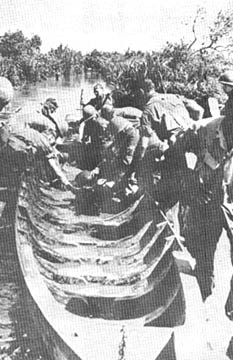 |
BAIL AND SAIL - This sampan was discovered by Delta Company, 2d Battalion, 27th Infantry. The Wolfhounds were working in the swampy area west of Saigon when they found the sunken boat. (PHOTO BY SP4 ROBERT WILLIAMS) |
Gen Abrams Presents Award
Manchu Wins DSC
CU CHI - During a brief ceremony at Fire Support Base Patton north
of Cu Chi, General Creighton W. Abrams, Commander of the U.S. Military Command
Vietnam, presented the nation's second highest award for heroism to Specialist
5 Ronald J. Soppe, West Union, Iowa.
The 2d Brigade soldier from the 1st Battalion (Mechanized), 5th
Infantry, was presented the Distinguished Service Cross for extraordinary
heroism while serving as a medic with the Mech in the Ben Cui rubber plantation
on September 11, 1968.
Soppe's unit was attacked at their night laager by an estimated
enemy battalion. He maneuvered from position to position to aid wounded
comrades in the midst of the rocket, machine gun and small arms attack.
During the battle one armored personnel carrier was hit and set on
fire. Soppe ran to the track and extinguished the blaze.
Although wounded, Soppe reached the man and then despite his
condition continued to aid six others.
| GENERAL CREIGHTON W. ABRAMS congratulates Specialist 5 Ronald Soppe after presenting him with a DSC. (PHOTO BY FRANK HEINY) | 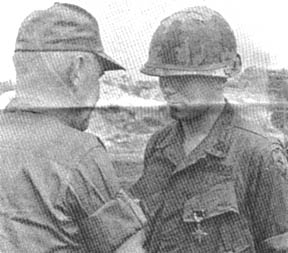 |
Cong Mini-Motorpool Found Near Tay Ninh
TAY NINH - C Company of the 4th Battalion, 9th Infantry Manchus
captured 16 enemy bicycles and three motorcycles.
The 25th Infantry Division troops uncovered the VC mini-motorpool a
half-mile from a fire support base northeast of Tay Ninh Base Camp.
Private First Class Joseph Roszko, DuPont, Pa., said the Manchus
found the vehicles while sweeping near a road.
"We saw the Hondas right near the side of the road," Roszko
said. "Then, when we started looking around, we found the bicycles covered
with a big pile of straw."
Adding insult to injury, the Manchus rode the bikes and motor
scooters back to St. Barbara.
Defoliation Exposes VC Lairs Along Saigon River
DAU TIENG - Finding caches and spotting potential ambush sites
along the Saigon River, near Dau Tieng, will be made easier thanks to the work
of a combined forces defoliation team working with the 3d Brigade.
The team is made up of soldiers from the 1st Battalion, 27th
Infantry, and sailors from the Vietnamese Navy's 28th River Assault Group.
While the Tropic Lightning soldiers provide security on the river
banks, the Vietnamese sailors transport the defoliation equipment into position
and aid in the actual defoliation.
Using high pressure hoses, the team sprays defoliant up to 10
meters inland. These areas are considered prime hiding places for the Viet
Cong and their munitions caches.
The team chief, Captain Lawayne Wyatt, an advisor from the 25th
Infantry Division chemical section, selects potential sites and determines what
type of equipment is best suited for the varying terrain.
"We plan to spray about ten miles of the river to deny Charlie
the use of this area for his ambush and cache sites," commented Wyatt. "The growth along the river banks," noted the Greenwood, Ind., native, "is
some of the heaviest I've ever seen."
Chief Petty Offfcer Joseph F. McGowan, of Boston, an advisor to the
Vietnamese Navy feels that the operation is a success not only in the
defoliation of the river banks but also in building stronger ties between
Americans and Vietnamese.
The men, according to the chief, are being exposed to the
professionalism of the Vietnamese Navy.
"Many of the soldiers have been in contact with the Navy so this
is a good way to see how the riverine force operates," said the chief. "I'm sure everyone will benefit from this operation except Charlie of
course," grinned the Navy veteran.
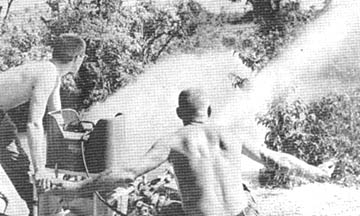 |
USING HIGH PRESSURE pumps to spray defoliant on potential VC cache and ambush sites are Captain Lawayne Wyatt (left) and U.S. Navy Chief Petty Officer Joseph F. McGowan. The defoliation team operated on the Saigon River near Dau Tieng. (PHOTO BY SGT HECTOR NADAL) |
Page 4-5 TROPIC LIGHTNING NEWS March 24, 1969
Mobility And Support Firepower On Call
Helicopters Are The Infantry's Third Flank
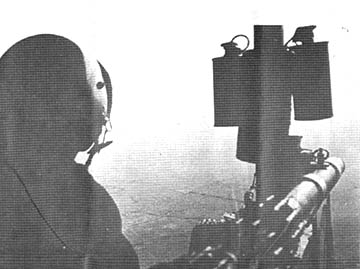 |
A DOORGUNNER on a Fire Brigade command and control helicopter keeps a close watch on a mission in the Cu Chi area. (PHOTO BY SP5 FRANK HEINY) |
| A CRUSADER HELICOPTER of the 187th Assault Helicopter Company sets down southeast of Tay Ninh City during an eagle flight. Landing in a rice paddy were Manchus of the 4th Battalion, 9th Infantry. (PHOTO BY SP4 H.J. TSCHIRNER) | 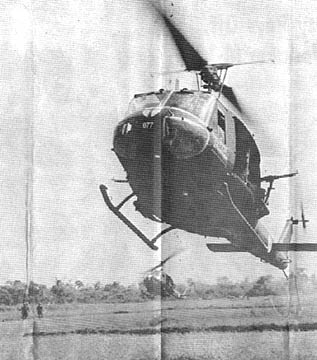 |
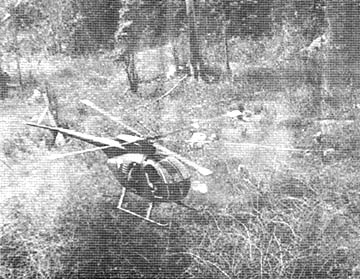 |
SUPPORT FOR LIGHTNING INFANTRY - A Light Observation Helicopter (Cayuse), part of C Troop, 3d Squadron, 17th Air Cavalry's hunter-killer teams, strafes a suspected enemy hiding place 11 miles northwest of Tay Ninh City. The Cayuse is supporting ground troops. (PHOTO BY CPT LES RASCHKO) |
| A WOLFHOUND TROOPER from Charlie Company, 2d Battalion, 27th Infantry, watches as a Hornet chopper of the 116th Assault Helicopter Company flies over a hamlet near Fire Support Base Reed. (PHOTO BY SP4 KARL KARLGAARD) | 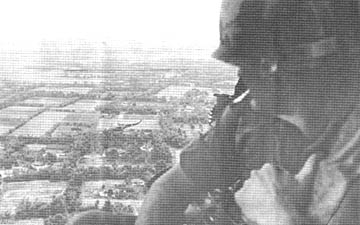 |
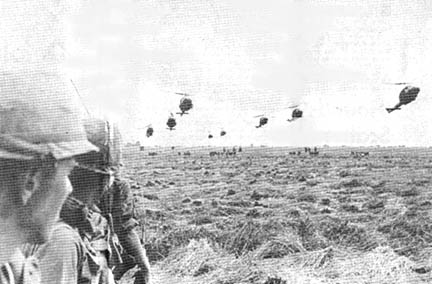 |
AWAITING THE EAGLE FLIGHT - Wolfhounds from Charlie Company, 2d Battalion, 27th Infantry, watch as an eagle flight approaches to take them "home" after a day of searching for the enemy. The Fire Brigade soldiers were working in the An Phu area northwest of Cu Chi. The sight of the precise formation of the 116th choppers is a pleasant one for the Wolfhounds after a day in the field. (PHOTO BY SP4 KARL KARLGAARD) |
Page 6 TROPIC LIGHTNING NEWS March 24, 1969
A Little Ingenuity Pays Off, Old Grenades Work For M-16
DAU TIENG - An ideal method of marking enemy positions without
exposing their own location is now available to forward artillery observers of
the 3d Brigade.
The new technique, a brainchild of Lieutenant Colonel Vernon B.
Lewis of Marshall, Tex., borrows something from the past. It is based on
an old M-1 rifle smoke grenade.
Lewis, commander of the 'Up Tight' 2d Battalion, 77th
Artillery, noticed that the old M-1 smoke grenade would fit snugly over the
muzzle of an M-16.
"We wanted something that would enable our forward observers to
mark enemy positions more exactly for the benefit of aerial observers," said
Major Robert Mosse of Russellville, Ark., battalion executive officer.
The weapon fires with a slight recoil, but is quite accurate. Moose
gave a demonstration of it for visitors to 'Up Tight' headquarters in Dau
Tieng base camp, 45 miles northwest of Saigon.
"We're not sure that someone else didn't think of this
first," said Captain James R. Suffern, N.Y., battalion liaison officer. "But
as far as we know the 2d of the 77th is the first artillery unit to use this
smoke grenade marker in combat in Vietnam."
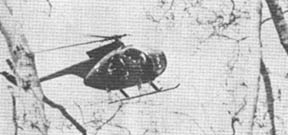 |
PEEKING through the trees above an NVA base camp is an OH6A Cayuse from the 3d Squadron, 17th Air Cavalry 1st Lieutenant Daniel W Gains of East Point, Ga, piloted the craft which made the initial findings leading to a 315-ton rice cache near Tay Ninh (PHOTO BY SP4 DAVE DEMAURO) |
Good Lesson For NVA: Don't Shoot At A LOH!
TAY NINH - North Vietnamese Army troops manning .51 caliber machine
gun positions near the Cambodian border recently called down the thunder from
the skies when they fired on a scout helicopter carrying the artillery liaison
officer of the 4th Battalion, 9th Infantry.
First Lieutenant Mark E. Barker, Ravensdale, Wash., the liaison
officer, and Major Harry D. Ray Jr., Dillon, Mont., the Manchus' operations
officer, were riding herd on a B Company airmobile operation when they spotted
the positions near a creek.
Barker called in fire from the B Battery, 2d Battalion, 77th
Artillery 105mm howitzers at Fire Support Base Sedgwick, which fired 600 rounds
during the four-hour operation.
"The rounds looked good, and we saw a secondary explosion, so we
told the chopper pilot to take us down for a closer look," Barker said. "When we got down near the ground, we started drawing fire, and we got hit
with enough of it to worry for a while if we might not be going down."
| BORROWING from something old and something new, artillerymen of the 'Up Tight' 2d Battalion, 77th Artillery, have devised a new way to mark enemy positions without exposing friendly locations. Major Robert G. Mosse of Russellville, Ark., demonstrates an M-1 smoke grenade which is used with the M-16. The smoke grenade is being used by Forward Observers with the 3d brigade. (PHOTO BY CPT R. A. STEINHAUSEN) | 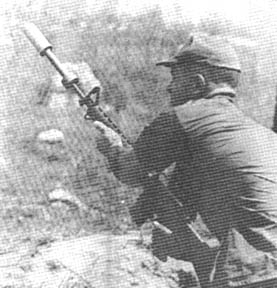 |
Southeast Asia Not New To Real 'Marauder'
DAU TIENG - Southeast Asia and Bravo Company Triple Deuce are
becoming a way of life for First Sergeant Arthur A. Werner of Tacoma, Wash.
The former member of Merrill's Marauders recently began his
second tour in Vietnam with the same outfit he was with two years ago - B
Company, 2d Battalion (Mech), 22nd Infantry.
Werner's military career, which stretches back to before World
War II, has brought him many close brushes with death.
He fought at Guadalcanal and in the Solomon Islands at Vella La
Vella before volunteering for a new regiment which was being organized to fight
in Burma - the famed Merrill's Marauders.
He learned guerilla fighting in India before the long fight in the
jungles which resulted in capture of the Japanese airfield at Mytkyina and the
opening of the Burma Road. Because of malaria, typhoid and high
casualties, many of the Marauders never returned.
Six years later, the Tropic Lightning topkick also served in Korea,
after several years out of the Army. He received a direct commission and
commanded a rifle company of the 224th Regiment. Once again Werner was in
the thick of the fighting.
His war experiences in Vietnam date back to the arrival of the
Triple Deuce and its armored personnel carriers from Fort Lewis, Wash., in 1966.
Through fierce fighting during Operations Logo, Attleboro, Junction City, Cedar
Falls and Yellowstone the men of his company dealt devastating blows to the
enemy.
Werner recalls the first time the Triple Deuce rolled into Dau
Tieng to establish its home at the 3d Brigade base camp, 45 miles northwest of
Saigon.
Werner also fought in one of the biggest single-day actions of the
Vietnam conflict, the Battle of Soui Tre, in which the Triple Deuce reacted to
her sister battalion, the 3d of the 22d Regulars, resulting in the deaths of
more than 300 enemy.
In May of 1967 Werner was wounded and evacuated to the United
States. When he again received orders for Vietnam early this year, he
found he was headed back to his old unit - B Company Triple Deuce.
'Hounds' Scatter VC
CU CHI - Fire Brigade soldiers of the 2d Battalion, 27th Infantry
Wolfhounds recently clashed with an unknown number of enemy near the Cambodian
border.
A night patrol unknowingly walked into a small group of enemy
soldiers. The point man, Specialist 4 Darwin Kuntenback, Dimock, S.D.,
attempted to fire his M-79 but the round misfired.
An enemy soldier then threw a hand grenade at Kuntenback.
Miraculously the grenade only knocked him off his feet.
"I sure was lucky," the Tropic Lightning soldier said, "I
thought I was a goner."
The other men in the patrol opened fire on the AK-armed enemy and
the fleeing VC left three dead behind.
Page 7 TROPIC LIGHTNING NEWS March 24, 1969
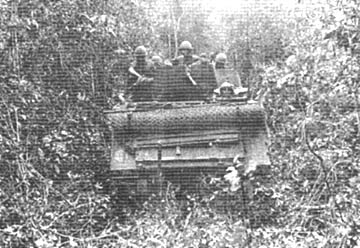 |
THROUGH THE WOODS - An armored personnel carrier from the 3/4 Cav mashes its way through the Boi Loi Woods in search of Charlie. (PHOTO BY SP4 JIM BRAYER) |
| CHECK UP - Specialist 6 Robert R. Caudillo, Ukiah, Calif., treats a small Vietnamese child for an ear infection. Caudillo is a 2d Brigade soldier with the ¾ Cav. (PHOTO BY SP5 JERREL JARVIS) | 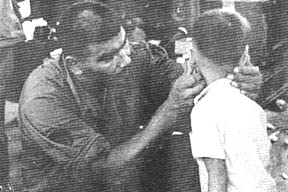 |
When There's A Job To Do Call On The Versatile
3/4 Cav
By SP4 Robinson Truitt
CU CHI - Perhaps the single most versatile unit in the 25th
Infantry Division is the 3d Squadron, 4th Cavalry. The Cav is unique in that it
is a composite of all the combat branches and has the capability to launch both
ground and air operations against the enemy.
A, B and C troops are the Cav's fighting arm on the ground.
The three platoons in a typical line troop are each broken down into a scout
section, a tank section, a mechanized infantry squad, and a mortar section.
Each section is mechanized, mounted either on armored personnel carriers or on
tanks.
What makes a 3/4 Cav platoon such an effective fighting unit is its
tremendous firepower and mobility. On the tanks are mounted 90mm guns, a
.50 caliber machine gun and two M-73 machine guns. The mortar track
carries a 4.2 inch mortar and a .50 caliber machine gun. And each of the
four scout section tracks carries a .50 caliber machine gun plus two M-40
machine guns.
Infantrymen with M-16s and M-79 grenade launchers ride on another
similarly armed track ready to dismount and engage the enemy in support of the
armored sections. And this tight little fighting force is commanded by the
platoon leader from his own track.
With so many lives and fighting capabilities dependent on so much
machinery, proper maintenance becomes critically important, and the battle
readiness of a 3/4 Cav line troop is determined by it. Each troop has a
VTR (track recovery vehicle), a 1,000 horsepower behemoth which is to a tank
what a tow truck is to a car. Squadron Maintenance performs a
24-hour-a-day job, both servicing wheeled and tracked vehicles and repairing
those damaged by mines and RPGs.
A ground troop would be quite helpless without information on the
enemy and the Cav's D Troop is the airborne eyes and ears of the squadron.
The scouts who fly the OH-6A Light Observation Helicopters must be highly
qualified and experienced aviators to perform the dangerous mission of low-level
and contour flights in search of the enemy.
But reconnaissance is only one of D Troop's tasks. The
scouts need support, and Huey gunships and Cobras fly at high altitudes, ready
to give massive firepower assistance not only in the aid of the scouts, but also
for the line troops and other units in the 25th Infantry Division.
D Troop even has its own infantry platoon, the Aero-Rifles which
makes it possible for the troop to conduct limited ground operations on their
own, or in coordination with the rest of the squadron.
Attached to the 3/4 Cav though not a part of it, is Company F, 50th
Infantry (LRP) Long Range Patrol.
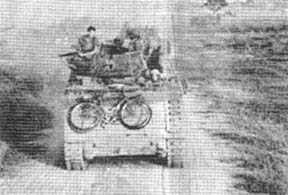 |
AN APC from the Cav's C Troop rumbles down the road with two bikes strapped to its front. The two wheelers were part of a cache containing more than 300 bicycles. (PHOTO BY SP5 JERREL JARVIS) |
| RICE TRANSPORT - A chopper from Delta Troop of the Cav lifts out a sling laden with captured rice. The rice cache was found by 2d Brigade soldiers north of the Tropic Lightning base camp at Cu Chi. (PHOTO BY SP5 JERREL JARVIS) | 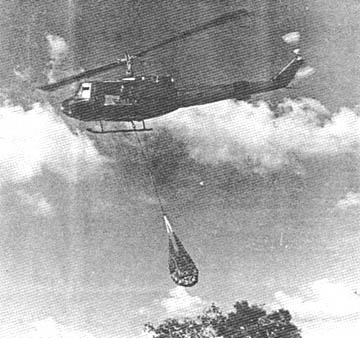 |
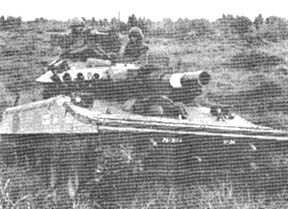 |
A SHERIDAN (bottom left) carries a 152mm main gun with a co-axially mounted machine gun, a .50 caliber machinegun and four grenade launchers mounted on either side of the turret. (PHOTO BY SP4 ROBINSON TRUITT) |
Page 8 TROPIC LIGHTNING NEWS March 24, 1969
But It's 'Soccer To Me'
Some People Call It Vietnamese Football
TAY NINH - The final score of the soccer match stood at 3-1, the
local South Vietnamese Regional Forces (RF) element over Bravo Company of the
4th Battalion, 9th Infantry Manchus.
But that soccer defeat, in a surprisingly close, hard-fought game,
was the only loss anybody noticed in a day-long combined sports outing and civic
action project that approached county fair proportions at Thieu Thom village, 14
miles southeast of Tay Ninh.
Understanding, cooperation, sportsmanship and compassion were some
of the victories shared by the men of the 25th Infantry Division.
Bravo Company commander, Captain George H. Dias, Jr., Fayetteville,
N.C., summed up things this way.
"We've never had many problems working with the Vietnamese
forces around here, but this was an excellent way for us all to get to know each other
better.
"Most of our men hadn't played much soccer before, so the
villagers were laughing at us at the start of the game, but by the time it was
over, they were laughing with us. And while they saw that we know how to
play hard, what's more important is that they saw we know how to lose, doing
our best and shaking hands when it's over."
The soccer game was just a part, however, of a full day of
activities.
While other elements of Bravo Company provided security, a Medical
Civic Action Project (MEDCAP) team led by Manchu battalion surgeon, Captain
Thomas R. Thurman, Hedrick, Iowa, treated more than 200 villagers.
Specialist 4 Mike D. Petoskey, Mt. Morris, Mich., and Specialist 4
Robert L. Henderson, Vallejo, Calif., assisted Thurman. Petoskey described
the MEDCAP as "probably the best one I've been on."
The Manchu's S-5 Civic Action section contributed powdered foods
and reading material for the villagers, plus T-shirts for the winning team.
Assistant S-5 Specialist 4 Lynn B. Johnson, Santa Cruz, Calif., who also
arranged for a plaque to be made for the winning team, collected S-5's
contributions to the day in less than 48 hours, doing what Dias called "a
fantastic job."
In the soccer match, Platoon Sergeant Ronald S. ("Fig the
Foot") Figueroa, Miami, Fla., accounted for the Manchus playing under a free
substitution system that is slightly irregular in soccer circles but probably
saved some US heat casualties. Figueroa only played about two minutes of
the 80-minute game, but he made his time count.
"I was just coming in from the side when the ball came rolling in
front of me, so I kicked it in," Figueroa said.
Specialist 4 Mike T. Crary, Fargo, N.D., handled the troops
goal-keeping chores, exposing himself to the RF's line-drive shots with
complete disregard for his own safety.
But Private First Class Martin B. Reiss, East Meadow, Long Island,
N.Y., pinpointed the key to the whole event when he said that "it was mainly a
lot of fun for everybody concerned."
"This was the best thing for morale I've seen in a long
time," Reiss said. "In an exhausting way, it was a great relaxation
for us."
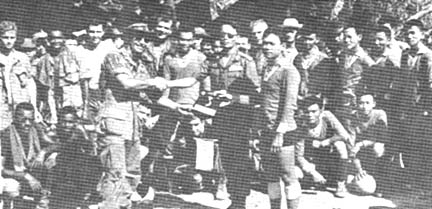 |
| CONGRATULATIONS - A plaque symbolic of victory in a Manchu-Regional Forces soccer match is handed to the commander of the local element by Captain George H. Dias, Jr., Fayetteville, N.C. Dias is the CO of Bravo Company of the 4th Battalion, 9th Infantry Manchus. (PHOTO BY SP4 H. J. TSCHIRNER) |
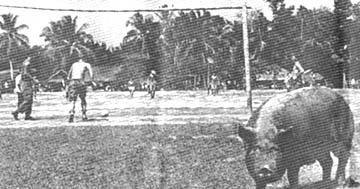 |
| PIGSKIN PROTEST - "We pigs are always getting kicked around, but this is ridiculous," this porker might be saying as he walks out on the soccer match between the Manchus and a local South Vietnamese Regional Force element. The U.S. troopers went down 3-1 to the more experienced Vietnamese. (PHOTO BY SP4 H.J. TSCHIRNER) |
Gunner Sights GED Degree
TAY NINH - While working as an assistant gunner for eight and one
half months, Specialist 4 James O. Smith of College Corner, Ohio, earned his
General Education Diploma (GED). With the proper authorization the GED can
be turned into a regular high school diploma.
Smith of Delta Company of the 3d Battalion, 22d Infantry, carried
his schoolbooks in his field pack while operating in forward areas. While
most of his buddies would be writing letters home he would be studying his
assignments.
Smith was transferred recently to the battalion mess hall to be
trained as a cook. This assignment enabled Smith to study during the
evening hours utilizing the mess hall as a study.
Major Joseph Hacia, executive officer of the 3d Battalion, 22d
Infantry, presented the GED to Smith. "I have presented many different
types of awards," said Hacia. "This diploma means that you have a much
larger earning capacity. No other award or certificate can be of more
value to you than this diploma."
Smith plans to further his education after his tour in Vietnam.
Mole Manchus Are Decorated
TAY NINH - Decorations for valor in the December battle of Patrol
Base Mole City were presented to 61 soldiers of the 4th Battalion, 9th Infantry
Manchus at the battle site.
Division commander Major General Ellis W. Williamson and battalion
commander Lieutenant Colonel Leo L. Wilson, Salina, Kans., made the awards in a
ceremony among the bunkers where 350 Tropic Lightning troops turned back a
midnight attack by an estimated regimental-sized enemy force. The official
toll of enemy killed was 103.
Eleven Silver Stars, 23 Bronze Stars with "V" device for valor
and 27 Army Commendation Medals with "V" device were awarded. Another
20 medals, including 11 more Silver Stars, have been approved for soldiers not
present at the ceremony.
General Williamson told the First Brigade soldiers they had
"taught the enemy a real lesson."
"We've been teaching him a lot of lessons lately," Williamson
added. "Pretty soon he's going to become convinced that he has nothing
to gain by continuing this war."
Mole City has been renamed Fire Support Base Sedgwick because
artillery has been added. But it is still built around the bunker and
trench system that inspired its original name.
| WELL DONE - Major General Ellis W. Williamson, Division Commander, congratulates 34 medal winners from the 4th Battalion, 9th Infantry Manchus. (PHOTO BY PFC RALPH NOVAK) | 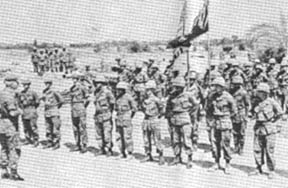 |
Thanks to
Mack D. Gooding, 15th PID, 1st Bde., for sharing this issue,
Kirk Ramsey, 2nd Bn., 14th Inf. for creating this page.
This page last modified 8-12-2004
©2004 25th Infantry Division Association. All rights reserved.